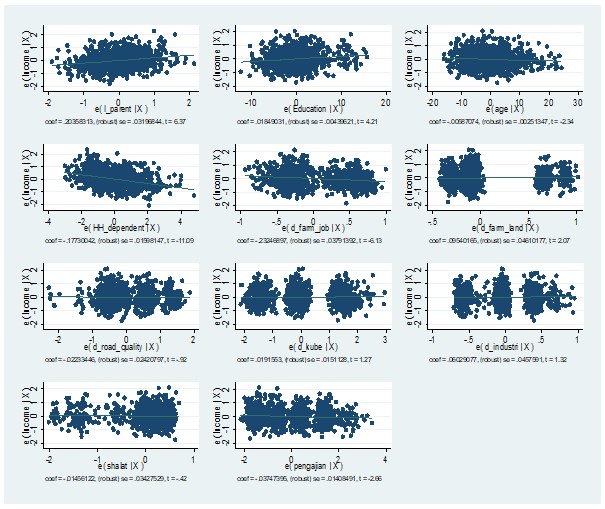Intergenerational Income and Religiosity: A Longitudinal Study of Agricultural Household in Indonesia
Abstract
This study aimed to analyze the influence of religiosity and socio-economic determinant factors to income relationship between inter-generationsof farmers and their children. Data related to farmers (parents) were collected from (Indonesia Family Live Survey) IFLS-93, while data related to farmers' children was obtained by tracing in IFLS-2014. The 21-year interval is supposed to be sufficient time to grasp developments between generations. The results revealed that farmer children's households have better economic potential than that of their parents. Comparing to the poor farming households, the percentage of the poor generation is higher than non-poor farmer households. The income of parents (farmers) and the education of farmers' children are factors that play an important role in increasing the income of farmers' children, having strong (robust) and significant positive effect. Another variable that has positive significant effect is agricultural land ownership, while age, household burden, working in agriculture, and religiosity-religion have negative significant effects. Implementation of religiosity activities should be encouraging productivity and prosperity of life in accordance with the guidelines and rules in Islam.
References
Bakar, A., Lee, R., & Hazarina Hashim, N. (2013). Parsing religiosity, guilt and materialism on consumer ethics. Journal of Islamic Marketing, 4(3), 232-244. https://doi.org/10.1108/JIMA-04-2012-0018
Belfield, C., Crawford, C., Greaves, E., Gregg, P., & Macmillan, L. (2017). Intergenerational Income Persistence within Families. Centre for the Economics of Education, W17/11. https://doi.org/10.1920/wp.ifs.2017.W1711
Bevis, L. E. M., & Barrett, C. B. (2015). Decomposing Intergenerational Income Elasticity: The Gender-differentiated Contribution of Capital Transmission in Rural Philippines. World Development, 74, 233-252. https://doi.org/10.1016/j.worlddev.2015.04.010
Chetty, R., Hendren, N., Kline, P., & Saez, E. (2014). Where is the land of opportunity? The geography of intergenerational mobility in the United States. Quarterly Journal of Economics, 129(4), 1553-1623. https://doi.org/10.1093/qje/qju022
Chuard, P., & Grassi, V. (2020). Switzer-Land of Opportunity: Intergenerational Income Mobility in the Land of Vocational Education. SSRN Electronic Journal. https://doi.org/10.2139/ssrn.3662560
Corak, M., & Heisz, A. (1999). Board of Regents of the University of Wisconsin System The Intergenerational Earnings and Income Mobility of Canadian Men: Evidence from Longitudinal Income Tax Data The Intergenerational Earnings and Income Mobility of Canadian Men Evidence from Longitud. Source: The Journal of Human Resources, 34(3), 504-533. https://doi.org/10.2307/146378
Dang, T. (2020). Intergenerational Earnings and Income Mobility in Vietnam. Labour, 34(1), 113-136. https://doi.org/10.1111/labr.12164
Davies, A. (2004). The Role Of Religion In The Economy. International Journal on World Peace, 21(2), 37-42. https://www.jstor.org/stable/20753439
Diener, E., Tay, L., & Myers, D. G. (2011). The religion paradox: If religion makes people happy, why are so many dropping out? Journal of Personality and Social Psychology, 101(6), 1278-1290. https://doi.org/10.1037/a0024402
Glock, C. Y. (1962). Religious Education : The Official Commitment On The Study Of Religious Commitment 1. Journal of the Religious Education Association, 57(4), 98-110. https://doi.org/10.1080/003440862057S407
Gong, H., Leigh, A., & Meng, X. (2012). Intergenerational income mobility in urban China. Review of Income and Wealth, 58(3), 481-503. https://doi.org/10.1111/j.1475-4991.2012.00495.x
Gregg, P., Macmillan, L., & Vittori, C. (2019). Intergenerational income mobility: access to top jobs, the low-pay no-pay cycle and the role of education in a common framework. Journal of Population Economics, 32(2), 501-528. https://doi.org/10.1007/s00148-018-0722-z
Gujarati, D. (2012). Econometrics by Example. Palgrave Macmillan.
Herzer, D., & Strulik, H. (2017). Religiosity and income: a panel cointegration and causality analysis. Applied Economics, 49(30), 2922-2938. https://doi.org/10.1080/00036846.2016.1251562
Ilter, B., Bayraktaroglu, G., & Ipek, I. (2017). Impact of Islamic religiosity on materialistic values in Turkey. Journal of Islamic Marketing, 8(4), 533-557. https://doi.org/10.1108/jima-12-2015-0092
Jalan, J., & Ravallion, M. (1998). Determinants of Transient and Chronic Poverty: Evidence from Rural China. Policy Research Working Paper, June 1998. https://doi.org/10.1596/1813-9450-1936
Jin, M., Bai, X., Li, K. X., & Shi, W. (2019). Are we born equal: A study of intergenerational income mobility in China. Journal of Demographic Economics, 85(1), 1-19. https://doi.org/10.1017/dem.2018.19
Joshanloo, M., & Weijers, D. (2016). Religiosity Moderates the Relationship between Income Inequality and Life Satisfaction across the Globe. Social Indicators Research, 128(2), 731-750. https://doi.org/10.1007/s11205-015-1054-y
Khalid, M. A. (2018). Climbing the Ladder: Socioeconomic Mobility in Malaysia. Asian Economic Papers, 17(3), 1-23. https://doi.org/10.1162/asep_a_00624
Lee, C. I., & Solon, G. (2009). Trends in intergenerational income mobility. Review of Economics and Statistics, 91(4), 766-772. https://doi.org/10.1162/rest.91.4.766
Liao, Y. (2019). Does Education Improve Intergenerational Income Mobility? Open Journal of Social Sciences, 07(05), 86-98. https://doi.org/10.4236/jss.2019.75006
Mayer, S. E., & Lopoo, L. M. (2004). What do trends in the intergenerational economic mobility of sons and daughters in the United States mean? In Generational Income Mobility in North America and Europe. https://doi.org/10.1017/CBO9780511492549.006
Mellor, J. W. (1995). Agriculture on the Road to Industrialization. Published for the International Food Policy Research Institute, Johns Hopkins University Press.
Ministry of Agriculture. (2020). Statistik Ketenagakerjaan Sektor Pertanian 2020. In Ministry of Agriculture Republic Indonesia. Agricultural Data Center & Information System, Secretariat General Ministry of Agriculture Republic Indonesia.
Moeis, F. R., Dartanto, T., Moeis, J. P., & Ikhsan, M. (2020). A longitudinal study of agriculture households in Indonesia: The effect of land and labor mobility on welfare and poverty dynamics. World Development Perspectives, 20(September). https://doi.org/10.1016/j.wdp.2020.100261
Purbowati, A. (2018). Pengaruh Transfer Modal Manusia Antargenerasi Terhadap Mobilitas Pendapatan Antargenerasi Di Indonesia. Sosiohumaniora, 20(1), 1. https://doi.org/10.24198/sosiohumaniora.v20i1.10667
Simard-Duplain, G., & St-Denis, X. (2020). Exploration of the Role of Education in Intergenerational Income Mobility in Canada: Evidence from the Longitudinal and International Study of Adults. Canadian Public Policy, 46(3), 369-396. https://doi.org/10.3138/CPP.2019-072
Sitepu, A. (2016). Analisis Efektifitas Kelompok Usaha Bersama (Kube) Sebagai Instrumen Program Penanganan Fakir Miskin. Sosio Informa, 53-68. https://doi.org/10.33007/inf.v2i1.212
Solon, G. (2004). A model of intergenerational mobility variation over time and place. In Generational Income Mobility in North America and Europe (Issue 2004, pp. 38-47). https://doi.org/10.1017/CBO9780511492549.003
Solt, F., Habel, P., & Grant, J. T. (2011). Economic Inequality, Relative Power, and Religiosity. Social Science Quarterly, 92(2), 447-465. https://doi.org/10.1111/j.1540-6237.2011.00777.x
Storm, I. (2017). Does Economic Insecurity Predict Religiosity? Evidence from the European Social Survey 2002-2014. Sociology of Religion: A Quarterly Review, 78(2), 146-172. https://doi.org/10.1093/socrel/srw055
Tain, A. (2013). Faktor Dominan Penyebab Kemiskinan Rumah Tangga Nelayan Motor Tempel Di Wilayah Tangkap Lebih Jawa Timur. Sosiohumaniora, 15(1), 35. https://doi.org/10.24198/sosiohumaniora.v15i1.5237
Tanjung, G. S., Suryantini, A., & Utami, A. W. (2021). The priorities of leading sub-sector in the sector of agriculture, forestry, and fisheries in economic development in bangka belitung province. Agraris, 7(2), 160-175. https://doi.org/10.18196/agraris.V7I2.11615
Tomalin, E. (2018). Religions, poverty reduction and global development institutions. Palgrave Communications, 4(1). https://doi.org/10.1057/s41599-018-0167-8
Vieten, C., Scammell, S., Pilato, R., Ammondson, I., Pargament, K. I., & Lukoff, D. (2013). Spiritual and religious competencies for psychologists. Psychology of Religion and Spirituality, 5(3), 129-144. https://doi.org/10.1037/a0032699
Widodo, S. (2018). Pembangunan dan Politik Pertanian di Indonesia. In Caraka Tani: Journal of Sustainable Agriculture (Vol. 22, Issue 1, p. 26). https://doi.org/10.20961/carakatani.v22i1.20534
Wong, M. (2019). Intergenerational mobility in slums: Evidence from a field survey in Jakarta. Asian Development Review, 36(1), 1-19. https://doi.org/10.1162/adev_a_00121
Yousaf, S., & Malik, M. S. (2013). Evaluating the influences of religiosity and product involvement level on the consumers. Journal of Islamic Marketing, 4(2), 163-186. https://doi.org/10.1108/17590831311329296


This work is licensed under a Creative Commons Attribution 4.0 International License.
Copyright for this article is retained by the author(s), with first publication rights granted to the journal.
This is an open-access article distributed under the terms and conditions of the Creative Commons Attribution license (http://creativecommons.org/licenses/by/4.0/).









1.png)














